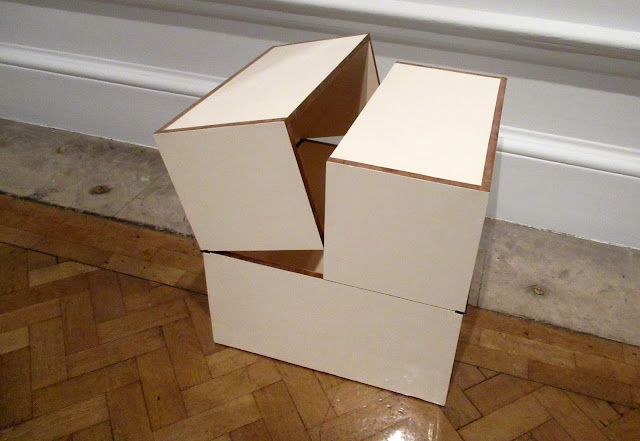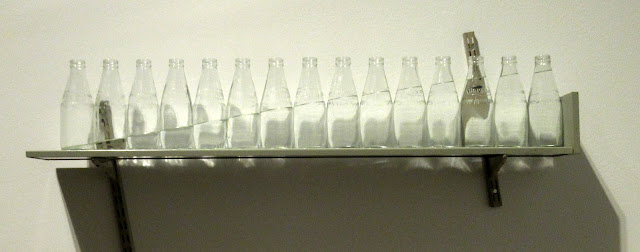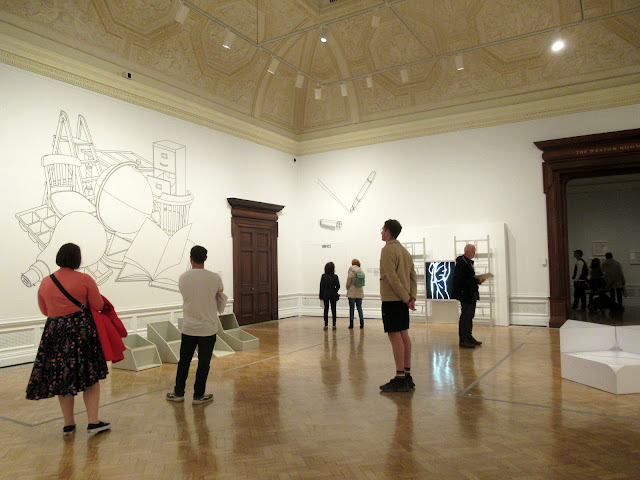Michael Craig-Martin at the Royal Academy of Arts.
This is the second post on this exhibition. You can see the first one here
Craig-Martin is one of the key figures in British conceptual art. Since coming to prominence in the late 1960s he has moved between sculpture, installation, painting, drawing, printmaking and digital media, creating works that fuse elements of pop, minimalism and conceptual art.
Educated primarily in the USA, Craig-Martin moved to the UK on completion of his studies in 1966. He exhibited the now iconic work An Oak Tree in 1973. From the mid-1970s he shifted his practice from using ready-made objects to representing them pictorially. Over the years he has developed a wide-ranging 'vocabulary' of everyday items including safety pins, light bulbs, take-away coffee cups and laptops.
Craig-Martin's intention is to explore ordinary contemporary life through the things we make, including consumer goods and works of art. He has sought to create works that are straightforward and undidactic, giving the viewer scope to use their imagination. His concern lies in understanding not just how we think and feel about the world, but how we perceive and experience it daily through the language of images.
Powder-coated steel sculptures in the forecourt of the Academy:
Quite a few of Craig-Martin's sculptures were displayed on the forecourt of the Academy. These monumental sculptures play with the tension between the three-dimensionality of sculpture and the two-dimensionality of drawing. Craig-Martin views these works as sculptures of drawings. From the front, the objects read as being two-dimensional and are easily identifiable, while from the side, the subjects collapse into a single line and the object depicted becomes strangely unreadable. The scale and colours used to represent these familiar items lend them a presence that is simultaneously modest and heroic.
Inside the galleries:
Early works:
Following his graduation from Yale School of Art in 1966, Craig-Martin began to produce sculptural works based on the minimalist and conceptual movements of the time. One of his earliest is Black Book, which transforms two mundade items into a work of art. Other early projects include his box pieces, which brought geometric forms together with functionality and direct audience participation.
From the early 1970s he began working with ready-made objects such as buckets, milk bottles and clipboards to produce a group of wall-based sculptures that explored the relationship between art and everyday items. Following An Oak Tree, Craig-Martin felt that he had reached a conclusion to the conceptual path he had been following and returned to basics through drawing and image-making.
Black Book, 1967, (cardboard and tape)
Box that Never Closes, 1967, (blockboard, polyurethane paint, varnish and brass hardware)
The lid and base do not fit together so the object cannot perform as an actual container, nor arrive at a neat geometric shape. Stripped of its standard use, Box That Never Closes plays with the viewer's expectations and invites us to question what makes an object a work of art.
On the Shelf, 1970, (15 milk bottles, water, metal shelf)
Image-Making and Readymades:
Reading Light, 1975, (neon)
In the second half of the 1970s Craig-Martin began working in pictorial representation and image-making, seeking a new way forward in his practice. His neon works were the first in which he drew rather than used real objects.
Untitled Painting No. 3, 1976, (oil on canvas)
His work with found objects continued with his series 'Pictures within Pictures'. By inserting paintings found in London flea markets into the top-left corner of blank canvases, he recontextualised the paintings in a way that 'completely changed their meaning without changing them at all'.
The following decade saw Craig-Martin return to 'readymades', prefabricated objects repurposed as art. He created a series of wall works using Venetian blinds, playfully questioning what we perceive as a painting. He then began to paint similar abstract works dominated by solid colour and patterns of white dashes. These were the first instance of his empathic use of colour.
Untitled (red), 1988
The artist's use of Venetian blinds plays with considerations of colour, form, light and space, with their shapes and solid colours suggesting a proximity to Abstract Expressionist colour-field painting. They also offer a metaphor for painting itself, framing a window onto the world.
Wall Drawings and Sculptures:
Influenced by Marcel Duchnap's use of prefabricated objects and Andy Warhol's focus on pop culture, Craig-Martin continued to incorporate recognisable manufactured items that were in his words, 'more famous than famous. So famous that you don't even notice them'.
He began producing drawings of ubiquitous items, using crepe tape on transparent acetate or drafting film, which were then projected and traced on the wall, again using tape. Through his choice of media, Craig-Martin sought to remove the artist's 'hand' so as to reflect the impersonal character of mass-produced objects. This method also enabled him to layer several drawings of objects, leading to complex compositions. He chose a three-quarter view, showing each object slightly from above to emphasive its three-dimensionality.
Craig-Martin 'draws' with a particular type of crepe tape invented in the 1960s for electronic circuitry. As with his wall drawings, it allows him to achieve his ideal of making the works 'styleless', eliminating all trace of the artist's 'hand'. Ironically, in attempting to make his work style-free he has created a style that is immediately recognisable as his own.
Reading with Globe, 1980, (tape on wall)
Pen and Ink, 1985, (painted steel)
In the early 1980s he began turning his drawings into wall-mounted sculptures, using thin metal rods. The linear simplicity of these drawings and sculptures became his hallmark and the foundaiton of his work to this day.
Sea Food, 1984, (oil on aluminium and painted steel)
Dolly, 1983, (oil on canvas and painted steel)
In this work, there is an early combination of flat and simplified lines, with the bold colours that would become characteristic of Craig-Martin's later style. Merging two modes of artistic expression, the colour blocks refer to abstract art, while the sculptural drawing is figurative.





















No comments:
Post a Comment